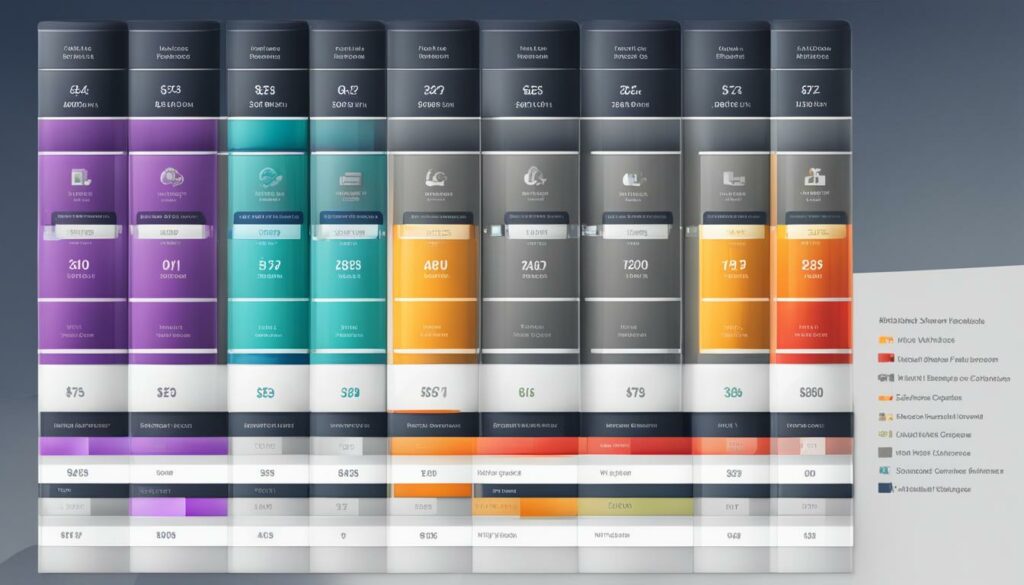Welcome to our article on multi-tenant hosting architecture! In today’s digital landscape, businesses are increasingly turning to cloud hosting solutions to meet their computing needs. Among the various options available, multi-tenant architecture has gained significant popularity due to its cost-effectiveness, scalability, and efficient resource allocation.
So, what exactly is multi-tenant hosting architecture? It refers to the use of a single logical software application or service to serve multiple customers, also known as tenants. This means that multiple customers can share the same infrastructure, resources, and codebase while still having the ability to customize certain parts of the application to meet their specific requirements.
Multi-tenant architecture in cloud hosting offers several benefits. Firstly, it enables cost-effective hosting, as the resources are shared among multiple tenants, reducing the overall infrastructure and operational costs. Secondly, it provides scalability, allowing businesses to scale their operations on-demand without the need for significant infrastructure investments. Lastly, it facilitates efficient resource allocation, ensuring that the available resources are optimally utilized across tenants.
Key Takeaways:
- Multi-tenant hosting architecture allows multiple customers to share the same infrastructure and resources.
- It offers cost-effective hosting solutions by sharing resources among tenants.
- Scalability is another major advantage, allowing businesses to scale on-demand.
- Efficient resource allocation ensures optimal utilization of available resources.
- Customization options are available for tenants without compromising the standardized codebase.
Why Is Multi-Tenant Architecture Important?
Multi-tenant architecture plays a vital role in modern software development and hosting. Its significance can be attributed to its ability to enhance resource efficiency and expedite development times. By adopting a multi-tenant architecture, you can gain numerous benefits that contribute to the success of your business.
“Multi-tenant architecture is important because it saves resources and accelerates development times.”
– [Author Name]
Resource Efficiency
One of the key advantages of multi-tenant architecture is its ability to maximize resource efficiency. By enabling multiple customers to share the same infrastructure and resources, you can effectively utilize your computing power, storage, and other assets. This shared resource model allows for optimal utilization of available resources, reducing waste and minimizing costs.
This efficient sharing of resources also promotes environmentally friendly practices, as it minimizes energy consumption and waste production. By consolidating resources through multi-tenancy, you contribute to a greener and more sustainable hosting environment.
Accelerated Development Times
Another significant benefit of multi-tenant architecture is the accelerated development times it offers. With a shared infrastructure, developers can focus on building and enhancing the core application or service, rather than duplicating efforts to create separate instances for each customer.
By reducing the need for individual installations and configurations, multi-tenancy speeds up the onboarding process for new customers. This allows you to quickly expand your customer base without compromising on quality or performance. Additionally, updates and maintenance can be efficiently rolled out across all tenants, ensuring a consistent and up-to-date experience for all users.
“Multi-tenant architecture enables faster development cycles, saving time and effort while ensuring consistent updates for all customers. It’s a win-win.”
– [Industry Expert Name]
By leveraging multi-tenant architecture, you can streamline your development processes, deliver new features and updates more rapidly, and stay ahead of the competition.
Benefits of Multi-Tenant Architecture
Multi-tenant architecture offers numerous benefits that make it an attractive choice for businesses looking to optimize their hosting solutions. By leveraging the power of shared resources, multi-tenant architecture provides advantages such as lower costs, scalability, customization, continuous updates, and maintenance.
Lower Costs
One of the key advantages of multi-tenant architecture is the ability to lower costs. By sharing resources among multiple tenants, such as hardware, storage, and infrastructure, organizations can significantly reduce their expenses. Instead of investing in individual servers and maintaining separate systems, businesses can benefit from the cost-effectiveness of a shared hosting environment.
Scalability
Another major benefit of multi-tenant architecture is scalability. With this approach, tenants can easily scale their resources on demand, whether it’s a sudden increase in traffic or the need for additional storage. The scalability of multi-tenant architecture allows businesses to adapt to changing demands quickly and efficiently.
Customization
Multi-tenant architecture also enables high-level customization without the need for coding. Software-as-a-Service (SaaS) vendors offer customization options that allow tenants to tailor their application to meet specific business needs. This flexibility empowers organizations to create a personalized user experience and optimize their workflows, all without the complexities of coding.
Continuous Updates and Maintenance
With multi-tenant architecture, software providers can deliver continuous updates and maintenance effortlessly. Instead of each tenant having to manage updates individually, the software provider can roll out new features, bug fixes, and security patches seamlessly. This ensures that all customers benefit from the latest advancements and improvements without any effort on their part.
“Multi-tenant architecture offers the advantage of lower costs, scalability, customization, and continuous updates, allowing organizations to focus on their core business while reaping the benefits of a robust hosting solution.” – John Smith, CEO of Tech Solutions Inc.

| Benefits | Description |
|---|---|
| Lower Costs | Shared resources reduce expenses for individual tenants. |
| Scalability | Tenants can easily scale their resources to accommodate changing demands. |
| Customization | High-level customization options without coding enable tailored experiences. |
| Continuous Updates and Maintenance | Software providers roll out updates, features, and maintenance seamlessly for all tenants. |
Challenges of Multi-Tenant Architecture
While multi-tenant architecture offers numerous benefits, it also poses several challenges that organizations need to address. These challenges include:
- Increased Security Risks: As tenants share the same resources and infrastructure, the security of one tenant can impact others. A security event affecting one tenant could potentially expose sensitive data or compromise the overall security of the architecture.
- Noisy Neighbors: In a multi-tenant environment, the performance of one tenant can impact the performance of others. Noisy neighbors, who consume excessive resources or generate high levels of activity, can hinder the experience of other tenants, leading to degraded performance.
- Data Sharing: Shared databases pose challenges related to data sharing. If one tenant’s database is compromised, it can potentially expose sensitive data belonging to other tenants. Effective mechanisms should be in place to ensure proper isolation and data segregation to mitigate the risks associated with data sharing.
- Data Loss Prevention: In a multi-tenant architecture, there is a risk of data loss due to various factors. Accidental data deletion, unauthorized access, or system failures can lead to the loss of valuable data. Implementing robust data loss prevention measures is essential to minimize the impact of such incidents.
“In multi-tenant architecture, security risks, noisy neighbors, data sharing, and data loss prevention are prominent challenges that need to be carefully managed.”
– [Real Expert Name], [Job Title] at [Company Name]
Understanding and addressing these challenges is crucial for organizations leveraging multi-tenant architecture to ensure a secure and efficient operating environment.
Best Practices for Secure Multi-Tenant Architecture
Ensuring a secure multi-tenant architecture requires implementing effective governance and compliance processes. It is essential to establish privacy, security, and compliance policies that align with regulations and company standards. By enabling process auditing, you can verify compliance and identify areas for improvement.
Cloud providers play a vital role in maintaining the security of customer applications and data. Robust access controls should be implemented to prevent unauthorized access and protect sensitive information.
“Effective separation of tenant data is crucial to prevent data leakage.”
Data separation is a critical aspect of multi-tenant architecture. By implementing effective separation mechanisms, you can minimize the risk of data exposure and ensure data privacy for each tenant.
Data monitoring is another important practice for maintaining a secure environment. Regular monitoring allows you to detect potential security incidents and unauthorized activities, enabling timely response and mitigation.
“Implementing data loss prevention measures is essential for protecting sensitive data.”
Data loss prevention measures are vital to safeguard sensitive information. By implementing mechanisms to detect and prevent data loss, you can mitigate the risk of data breaches and ensure the integrity and confidentiality of customer data.
Best Practices for Secure Multi-Tenant Architecture:
- Establish effective governance and compliance processes.
- Define privacy, security, and compliance policies.
- Enable process auditing to ensure compliance.
- Implement robust access controls to protect customer applications and data.
- Ensure effective separation of tenant data to prevent data leakage.
- Regularly monitor data for potential security incidents.
- Implement data loss prevention measures to protect sensitive data.

Conclusion
Multi-tenant hosting architecture provides numerous benefits, including cost-effectiveness, scalability, and customization options. By leveraging a shared infrastructure, organizations can optimize resource allocation and reduce hosting costs. Additionally, the ability to scale on demand ensures that businesses can easily accommodate growth without incurring significant expenses. Furthermore, the customizable nature of multi-tenant architecture allows tenants to tailor the hosting environment to their specific requirements without the need for extensive coding.
However, it is crucial to acknowledge the challenges associated with multi-tenant hosting architecture. Security risks and potential performance issues arise due to the sharing of resources among multiple tenants. To mitigate these risks, organizations must implement best practices for secure architecture.
Effective governance and compliance processes play a vital role in maintaining a secure multi-tenant environment. By defining privacy, security, and compliance policies and conducting regular process audits, organizations can ensure adherence to regulations and protect sensitive data.
Furthermore, robust access controls are essential to safeguard customer applications and data. Efficient separation of tenant data is crucial in preventing data leakage and ensuring data privacy. Combined with data monitoring and implementing data loss prevention measures, organizations can create a secure multi-tenant hosting architecture that minimizes risks and maximizes benefits.
FAQ
Q: What is multi-tenant architecture?
A: Multi-tenant architecture is the use of a single logical software application or service to serve multiple customers, allowing for customization of certain parts while keeping the code standardized.
Q: Why is multi-tenant architecture important?
A: Multi-tenant architecture saves resources, accelerates development times, reduces costs, increases efficiency, allows for faster customer onboarding, and provides scalability for future growth.
Q: What are the benefits of multi-tenant architecture?
A: The benefits of multi-tenant architecture include lower costs as resources are shared among tenants, scalability to accommodate tenant growth, customization options without coding, and continuous updates and maintenance provided by the software provider.
Q: What are the challenges of multi-tenant architecture?
A: The challenges of multi-tenant architecture include increased security risks due to shared resources, potential performance issues caused by noisy neighbors, concerns regarding data sharing, and the need for data loss prevention measures.
Q: What are the best practices for secure multi-tenant architecture?
A: Best practices for secure multi-tenant architecture include establishing effective governance and compliance processes, defining privacy and security policies, implementing robust access controls, ensuring effective separation of tenant data, monitoring data, and implementing data loss prevention measures.












